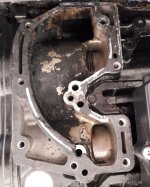New to this forum. Out of ideas.
Our mercury 25hp has been cared for since new. Last outing, it began losing one cylinder (loss of power), and would recover if we mashed on primer bulb constantly (got us home).
Carb was cleaned and inspected (dirty but nothing suspect).
Reassembled, engine will only fire intermittently now, Appears to get spark (HF tools spark tester, and grounded sparkplug method) to both plugs (new NK plugs)
With the carb off, I looked at the reed valves and they looked clean, closed and would return to position when I put pressure on them.
Fuel makes it to bowl (inspected fuel pump on carb when carb cleaned) and I can quirt fuel in engine with blue primer button on carb is pressed (also suggesting bowl is full). Occasionally will fire when I do this.
Compression (cheapo compression gauge measures 20psi on both cylinders (very low). However, I have a hard time believing that both cylinders have failed (unless head gasket failed...(which I see no sign of) given that this motor was pushing 4 people around last outing.
Not sure what to explore next.
Thanks in advance,
Rett
Our mercury 25hp has been cared for since new. Last outing, it began losing one cylinder (loss of power), and would recover if we mashed on primer bulb constantly (got us home).
Carb was cleaned and inspected (dirty but nothing suspect).
Reassembled, engine will only fire intermittently now, Appears to get spark (HF tools spark tester, and grounded sparkplug method) to both plugs (new NK plugs)
With the carb off, I looked at the reed valves and they looked clean, closed and would return to position when I put pressure on them.
Fuel makes it to bowl (inspected fuel pump on carb when carb cleaned) and I can quirt fuel in engine with blue primer button on carb is pressed (also suggesting bowl is full). Occasionally will fire when I do this.
Compression (cheapo compression gauge measures 20psi on both cylinders (very low). However, I have a hard time believing that both cylinders have failed (unless head gasket failed...(which I see no sign of) given that this motor was pushing 4 people around last outing.
Not sure what to explore next.
Thanks in advance,
Rett


